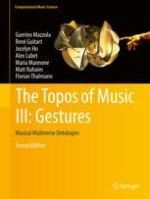2017 | Buch
The Topos of Music III: Gestures
Musical Multiverse Ontologies
verfasst von: Prof. Dr. Guerino Mazzola, René Guitart, Dr. Jocelyn Ho, Prof. Alex Lubet, Dr. Maria Mannone, Prof. Matt Rahaim, Dr. Florian Thalmann
Verlag: Springer International Publishing
Buchreihe : Computational Music Science
